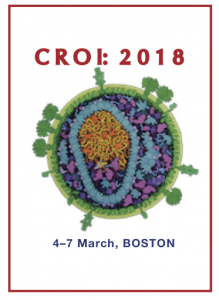Women’s risk of becoming HIV positive increases three-fold in late pregnancy and four-fold postpartum
30 March 2018. Related: Conference reports, CROI 25 (Retrovirus) 2018.
 Polly Clayden, HIV i-Base
Polly Clayden, HIV i-Base
The probability of HIV acquisition per condomless sex act rose steadily throughout pregnancy and was highest during the postpartum period in an analysis of two HIV prevention studies. This suggests that biological changes occurring during pregnancy and postpartum increase women’s HIV risk.
These findings were presented at CROI 2018 and also published online in The Journal of Infectious Diseases 5 March 2018. [1, 2]
Previous studies have found pregnancy to be a risk factor for HIV acquisition – a 2014 meta-analysis of five studies reported an increased risk of 30% overall with two showing double the risk and two other studies no increase.
For this analysis, investigators from Partners in Prevention HSV/HIV Transmission Study and Partners PrEP Study estimated the probability of HIV acquisition per sex act during pregnancy and postpartum and compared these probabilities to non-pregnant time periods.
The primary outcome was first evidence of HIV infection in HIV negative women linked to HIV positive male study partner.
Frequency of sex within partnership and condom use was reported monthly. HIV and pregnancy testing was monthly or quarterly depending on the original study. Time periods were categorised by reproductive stage: early pregnancy (0–13 weeks gestation), late pregnancy (14 weeks to delivery/loss), postpartum (delivery to 6 months; less for losses), or not pregnant/postpartum.
The investigators used a complementary log-log model adjusted for male partner viral load, active PrEP use, condom use and age. Reference case was a non-pregnant 25-year old woman, not using PrEP with male partner viral load 10,000 copies/mL.
Participants were 2,751 African HIV negative women with HIV positive male partners (not receiving ART) followed prospectively for up to 48 months in the two prevention studies. Data were censored from study visits after male partner started ART and seroconversions from unlinked HIV infections (from non-study partners).
At enrollment women were a median of 32.0 years of age (IQR 27.0–37.7); number of sex acts with study partner in the last month was 4.0 (IQR 2.0–8.0); and 670 (24%) had condomless sex with study partner in the past month.
Results accounted for decrease un sexual frequency and condom use as pregnancy progressed.
There were 686 pregnancies during follow up: 426 (62.1%) live births; 169 (24.6%) loss; and 91 (13.3%) ongoing at study exit.
Analysis of 78 new HIV infections revealed overall incidence per 100 person years of 1.62 (95% CI 1.29 to 2.01). Incidence varied considerably during the respective time periods: 1.25 (95% CI 0.95 to 1.62) during non-pregnant/-postpartum time; 5.37 (95% CI 3.44 to 7.99) during early pregnancy through postpartum; 3.75 (95% CI 1.22 to 8.75) during early pregnancy; 7.02 (95% CI 3.74 to 12.01) during late pregnancy; and 4.68 (95% CI 1.72 to 10.18) during postpartum.
HIV infectivity per 1000 sex acts (calculated using reference case) was: 1.05 during non-pregnant/-postpartum time; 2.19 during early pregnancy; 2.97 during late pregnancy; and 4.18 during postpartum.
Adjusted relative risk (RR) with non-pregnant/-postpartum as reference, early pregnancy through postpartum was 2.76 (95% CI 1.58 to 4.81), p<0.001. RR was 2.07 (95% CI 0.78 to 5.49), p=0.14 and 2.82 (95% CI .29 to 6.15), p=0.01, in early and late pregnancy respectively.
Sensitivity analyses using estimated data of HIV infection, excluding women randomised to active PrEP arms, excluding women who were never pregnant during follow up and including a longer postpartum period gave similar results.
In summary, there was a 3-fold increased risk of HIV per sex act in late pregnancy and 4-fold increase postpartum. The investigators noted that these results suggest that biological changes associated with pregnancy and postpartum, contribute to increased risk of HIV acquisition. But they did not directly assess any biological mechanisms for this phenomenon.
comment
As the investigators stressed, antenatal care presents tremendous opportunities to promote HIV prevention and care.
These data highlight the importance of four key points.
- Making sure women are counseling on this increased risk.
- Repeat HIV testing during maternal health visits, including closer to delivery and postpartum.
- Identifying HIV positive male partners and linking them to ART programmes.
- Promoting HIV prevention strategies during these periods of elevated risk, including oral PrEP.
References
- Thomson KA et al. Female HIV acquisition per sex act is elevated in late pregnancy and postpartum. 25th CROI. Boston. 4–7 March 2018.
Oral abstract 45.
www.croiconference.org/sessions/female-hiv-acquisition-sex-act-elevated-late-pregnancy-and-postpartum (abstract)
www.croiwebcasts.org/console/player/37088 (webcast) - Thomson KA et al. Increased risk of female HIV-1 acquisition throughout pregnancy and postpartum: a prospective per-coital act analysis among women with HIV-1 infected partners. The Journal of Infectious Diseases. Published online 5 March 2018.
https://academic.oup.com/jid/advance-article-abstract/doi/10.1093/infdis/jiy113/4915924

